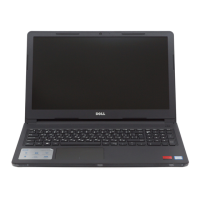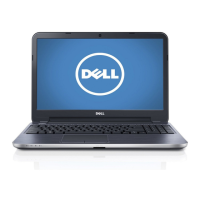How to run M-BIST
NOTE: M-BIST must be initiated on the system from a power-off state that is either connected to AC power or with
battery only.
1. Press and hold both the M key on the keyboard and the power button to initiate M-BIST.
2. With both the M key and the power button that is held down, the battery indicator LED may exhibit two states:
a. OFF: No fault detected with the system board
b. AMBER: Indicates a problem with the system board
Real Time Clock—RTC reset
The Real Time Clock (RTC) reset function allows you or the service technician to recover the recently launched model Dell
Latitude and Precision systems from No POST/No Boot/No Power situations. You can initiate the RTC reset on the system
from a power-off state only if it is connected to AC power. Press and hold the power button for 25 seconds. The system RTC
reset occurs after you release the power button.
NOTE: If AC power is disconnected from the system during the process or the power button is held longer than 40
seconds, the RTC reset process gets aborted.
The RTC reset will reset the BIOS to Defaults, un-provision Intel vPro and reset the system date and time. The following items
are unaffected by the RTC reset:
● Service Tag
● Asset Tag
● Ownership Tag
● Admin Password
● System Password
● HDD Password
● Key Databases
● System Logs
NOTE:
The IT administrator's vPro account and password on the system will be un-provisioned. The system needs to go
through the setup and configuration process again to reconnect it to the vPro server.
The below items may or may not reset based on your custom BIOS setting selections:
● Boot List
● Enable Legacy Option ROMs
● Secure Boot Enable
● Allow BIOS Downgrade
Handling swollen Lithium-ion batteries
Like most laptops, Dell laptops use lithium-ion batteries. One type of lithium-ion battery is the lithium-ion polymer battery.
Lithium-ion polymer batteries have increased in popularity in recent years and have become standard in the electronics industry
due to customer preferences for a slim form factor (especially with newer ultra-thin laptops) and long battery life. Inherent to
lithium-ion polymer battery technology is the potential for swelling of the battery cells.
Swollen battery may impact the performance of the laptop. To prevent possible further damage to the device enclosure or
internal components leading to malfunction, discontinue the use of the laptop and discharge it by disconnecting the AC adapter
and letting the battery drain.
Swollen batteries should not be used and should be replaced and disposed of properly. We recommend contacting Dell product
support for options to replace a swollen battery under the terms of the applicable warranty or service contract, including options
for replacement by a Dell authorized service technician.
The guidelines for handling and replacing Lithium-ion batteries are as follows:
● Exercise caution when handling Lithium-ion batteries.
● Discharge the battery before removing it from the system.
Troubleshooting
105

